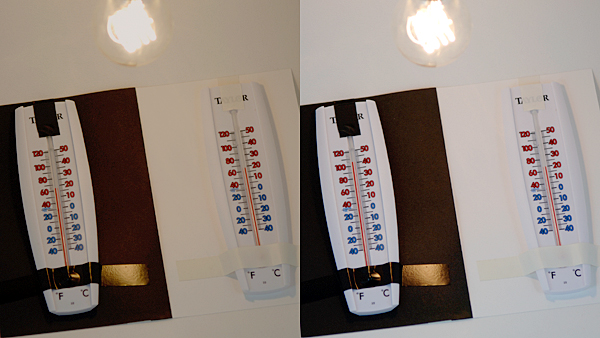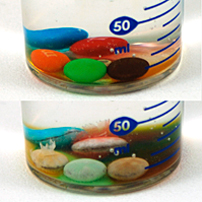Would a Dark Color M&M Melt Faster than a Light One?
First of all, for those of you reading outside the USA, M&Ms are small candies that are chocolate covered with a hard and colorful shell. Some places in Europe have a similar candy called "Smarties", or "Lacasitos", etc. M&Ms are designed to let you eat chocolate without fear of making a mess since the hard candy shell isn't supposed to melt in your hands. However, like anything it will melt if it gets hot enough, or if it gets wet enough (they melt in your mouth!).
This question is about how the color of the M&M relates to how quickly the candy will melt. If we assume that the colorants (chemicals giving a material its color) in the various M&Ms have no significant impact on its properties (see the image at the left for a case where this assumption fails), then in a darkened room followed by a darkened mouth, all M&M colors will melt at an equal rate.
The difference comes when the M&Ms are exposed to light like the thermometers in the image above. The dark colored M&Ms look dark because they are absorbing a lot of light. This light is energy and that energy has to go somewhere. For most materials that somewhere is a conversion into heat; the absorbed light makes the object hotter. This is the same reason we feel hotter in the direct sunlight than we do in the shade and people prefer to wear light colors on hot days and dark colors on cold days. So those M&Ms in the light will all heat up to different temperatures and the hotter ones will melt faster than the colder ones. It just turns out that the darker colors will also be the hotter M&Ms, so the bottom line is "yes" darker M&Ms will melt faster than light M&Ms if they have been exposed to enough light.
![]()
Explore the NEXT TOPIC at this level.
Explore the NEXT LEVEL on this topic.
Ever wonder ... If no light falls on an object does it still have a color?
Updated: Feb. 17, 2011

